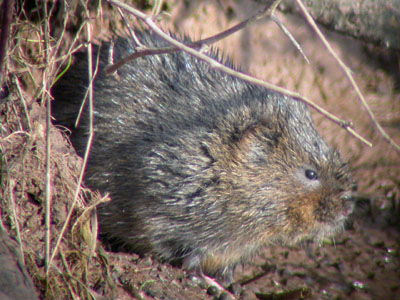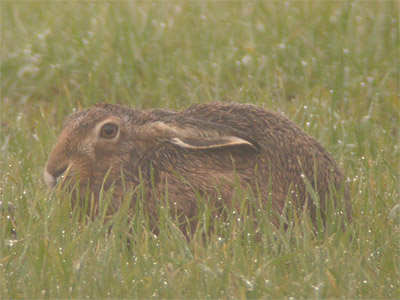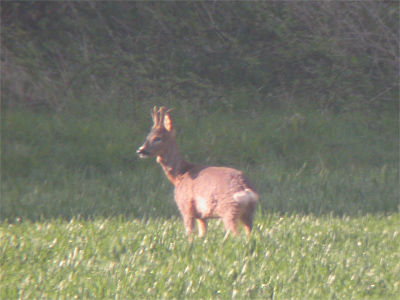 |
 |
| Mammals | ||
| Current species status at Eakring and Kersall | ||
| The variety of mammals found here is limited, though there have been some quite surprising sightings and discoveries over the years. All of the expected species are found, but the presence of both Badger and Water Vole definitely top the list. I have done little work on species variety and the list below is mostly made up of my own casual sightings since 1998. | ||
| Hedgehog Erinaceus
europeus |
|||
| The Hedgehog is surprisingly scarce and I have seen relatively few live Hedgehogs in the area. Eakring village and occasionally near Eakring Meadows have produced most records, although sadly, most sightings involve dead individuals. | |||
| Mole Talpa
europaea |
|||
| Very common throughout the area. | |||
| Pygmy
Shrew
Sorex minutus and
Common
Shrew
Sorex araneus |
|||
| Of the identified small rodents, the Eakring and Kersall area holds at least two species of Shrew - Pygmy Shrew and Common Shrew. Both are often heard, but sightings are generally confined to dead individuals along footpaths. | |||
| Short-tailed
Vole Microtus
agrestis and Bank Vole Clethrionomys
glareolus |
|||
| Short-tailed Vole is widespread and Bank Vole equally as common, forming a staple diet of the area's Barn Owls. | |||
| Water
Vole Arvicola terrestris |
|||
| The Water Vole is
probably the rarest breeding mammal found here, but have
not been recorded from the Eakring Flash area for several
years now. They are still declining nationally and are
one of our most threatened mammals. Although the population here appears to be small (we have done little work on their actual numbers) they are reasonably easy to see if you know when and where to look and have appeared to do quite well over recent years. They once favoured the slower moving stretch of The Beck at Eakring Flash and were often easier to see during the first half of the year when vegetation was short. |
 |
| Wood
Mouse
Apodemus sylvaticus and House
Mouse
Mus musculus |
|||
| Was only confirmed as occurring here in August 2003. House Mouse is as expected, very common. | |||
| Brown
Rat Rattus
norvegicus |
|||
| Very common. Brown Rats were an initial problem after Eakring Flash's creation in 1997 and their population during the following year rose to almost epidemic proportions. It was possible at that time to stand at almost any point around the site and be surrounded by Rats moving about within the growing vegetation. They certainly had an affect on the fledging success rates of breeding birds during 1998 and many young must have perished. | |||
| Grey
Squirrel
Sciurus carolinensis |
|||
| Widespread and increasing annually. | |||
| Rabbit Oryctolagus
cunniculus and Brown Hare Lepus capensis |
|||
| Very common in the area,
the Rabbit is pretty confined to a few particular sites. Like most other farmland wildlife, Brown Hares have suffered over the past decades. Although numbers are down on those of the 1950's the Eakring and Kersall area still manages to maintain a healthy population. Apparently the population here, makes up one of the highest Brown Hare population densities in Nottinghamshire. With the successful application for the Stewardship scheme by one farmer here, the future for the Brown Hare looks set to be safe-guarded for future years. |
 |
| Stoat Mustela
erminea and Weasel Mustela nivalis |
|||
| Stoat are sufficiently scarce enough to make sightings of them noteworthy. In nearly ten years coverage, I have probably seen them no more than four times and if there is a resident population here, it consists of no more then a few. Weasel is more regularly seen, but never commonly. The general Eakring Flash and Hare Hill Wood areas are the most regular places producing sightings. Note:- Although both Weasel and Stoat can be elusive, the substantial coverage the area receives should be sufficient enough to generate more frequent sightings of both. | |||
| American
Mink Mustela vison |
|||
| Following one seen around a small pond at Park Farm in 2008, a second record of this extremely unwelcome predator, came from Eakring Flash on March 1st 2009. One was watched hunting Rabbits at Penny Pasture Common, Eakring Meadows on October 29th 2009, with views down to five metres. | |||
| Fox Vulpes
vulpes |
|||
| Relatively common, though the area only holds maybe two or three pairs. | |||
| Badger Meles meles |
|||
| Found at one site (and possibly another) here. The only live Badger I have seen, came during a Summer evening in 2000, when one ran towards me down a private farm road. I have picked up three road casualties since 1998 and found one dead in the middle of a field with no obvious injury. | |||
| Roe
Deer Capreolus capriolus |
|||
| One of only
two Deer species recorded here to date is the Roe Deer
and most of the six records have referred to
short-staying individuals which moved through very
quickly, usually heading towards woodland. One sighting
though involved a female which remained for a whole
morning, often out in the open, but then took cover
underneath a Hawthorn bush in the Leyfields area. The
most seen on any one occasion was a group of five at Tug
Bridge Farm on an unknown date in 2006, which were
disturbed by crop-spraying. There was an increase in the number of Roe Deer sightings in late 2007 and early 2008. Two females were in fields at Red Hill on several occasions in October 2007. Two were seen crossing Eakring Meadows on April 19th 2008 (Robin Brace) one was at Lound Wood and Eakring Flash on April 29th 2008 and another was at Parkhill Plantation on May 2nd 2008. Numerous tracks were also found at Lound Wood, Hare Hill Wood during that time. |
 |
|
| ....... | ||
| In 2009, one was seen at Eakring Flash on May 7th and then again on May 10th. The most recent sightings was a group of three seen crossing fields from Parkhill Plantation and going into Eakring Meadows on January 15th 2010, followed much later in 2010 by another group of three in the Eakring Flash/Lound Wood and Church Hill areas on November 5th, 13th and 14th. | ||
| Muntjac Muntiacus reevesi |
|||
| One was present for several minutes on the lawn of Tug Bridge Farm in early April 2007. | |||
Related pages
|
||
| Homepage | ||
| Contents | ||